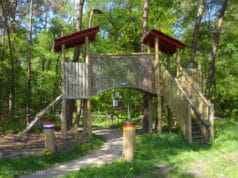After the devastation caused by World War II many Dutch people decided to leave their homeland. Large parts of the Netherlands had to be rebuilt, unemployment was high and there was a severe housing shortage. The idea that the situation would not improve any time soon was for many people the reason to start a new life in another country.
The Dutch government stimulated emigration and families moved to countries like Australia, Canada, the United States, South Africa and Brazil.
In 1948 a group of about 500 Catholics from North Brabant arrived in Brazil, establishing a colony at the 7,000 acres farm of Fazenda Ribeirão. It is located 140 kilometers northwest of São Paulo (more or less a two hour drive).
Hardship
The plan was to start farms with cattle from the Netherlands for the production of milk and dairy products. The first pioneers endured hardship, trying to farm in a country with conditions so different from what they were used to in the Netherlands. After the imported cattle died of tropical diseases some pioneers went into flower-growing. Others returned to the Netherlands or settled elsewhere in Brazil.
City of Flowers
This change in business was a huge success and Holambra is now a vibrant community. Most of the 12,000+ residents are descendents of Dutch emigrants. Today Holambra is known as ‘Cidade das Flores’ (meaning City of Flowers in Portuguese).
In 1991 a referendum was held on political autonomy for the area. After no less than 98% of the eligible population voted in favor of political autonomy, Holambra was granted city status.
Latin America’s main exporter of flowers
The area is now a large sea of blooming flowers, mainly for export. Holambra is the main exporter of flowers in the entire Latin America. The two cooperatieves of Holambra, Veiling and Cooperflora, accounts for 50% of all flowers and ornamental plants that are produced in Brazil.
Things to see and to do in Holambra
Museu Holambra
Informative museum with a large collection of photographs, films and objects from the early colonization period. In the outdoor area there are two replicas of houses the first settlers used to live and agricultural equipment illustrates the hard work the first farmers had to put in.
Moinho Povos Unidos windmill
This functional full-scale Dutch windmill is considered the largest windmill in Latin America. The upperdeck offers nice views of Holambra.
Expoflora
Holambra’s flower season has become a huge event in Brazil. The most spring famous event on the continent is Expoflora. Each year in September the city attracts some 325,000 visitors for the flower arrangement shows, landscaping exhibition and the manifestation of Dutch culture including like clog dances, fairground rides and lots of food and souvenir stalls.
Shower of flower petals at Expoflora
For Chuva de Petalas (‘Flower Rain’) 150kg of colorful rose petals are blown out over the crowd. The tradition says that anyone who grabs a rose petal from the air will have their wish come true.
Colorful facades
Some buildings in the urban center of Holambra have facades that resemble the stepped roof outlines found in Amsterdam.
Flower farms and flower fields
Tour agencies organize guided tours to flower farms and flower fields. Many of the farms are run by third generation growers and grow chrysanthemums, gerberas, roses and other species of flowers.
Garden Center Cidade das Flores
Gigantic supermarket-like garden shop where you can purchase every plant and flower imaginable. The 10,000m² garden center claims to sell the largest variety of flowers in the country.
The Old Dutch
Restaurant serving typical Dutch dishes, some of which are tropicalized. The menu includes bitterballen, Dutch smoked sausages, lamb stew and apple pie.
Oma Beppie stroopwafel factory
When the owner of Oma Beppie often received requests to bring stroopwafels from the Netherlands, he decided to experiment and make the stroopwafels by himself. The company is named after the owners grandmother (‘oma’) Beppie. Today the company employs nine people who make handmade stroopwafels which are sold in Holambra and the rest of Brazil.
Other Dutch colonies in Brazil
State of São Paulo: Holambra II
State of Paraná: Castrolanda, Carambeí, Arapotí
State of Minas Gerais: Brasolândia
State of Rio Grande do Sul: Não-Me-Toque



